Residing by the coast engenders a sense of ease and tranquility that most people want to emulate in their homes. Fresh air, soothing ocean sounds, and natural views evoke designs emphasising openness and comfort. In-home aged care customers would often prefer these traits since they make a home feel secure and uplifting. Through customised home design and décor reflecting a coastal way of life, family members can have an environment that fosters independence and relaxation.
The Role of Light and Space
In coastal-style living, things often start with natural light. Lots of windows, open spaces, and airy rooms create a feeling of welcoming and serenity. This style of design not only captures the coast’s beauty but also offers functional advantages to senior citizens who prefer light and easy-to-move-through environments. Spacious corridors, streamlined rooms, and tastefully located seating spaces combine function and fashion. They enable ease of movement with safety, balancing the invigorating feel of coastal-style homes.
A Connection to Nature
One of the most attractive aspects of coastal living is close proximity to nature. Creating a home that opens to gardens, patios, or outdoor seating areas assists in creating a transition between the indoors and outdoors. This is essential for one’s well-being, especially for those experiencing in-home aged care and spending more time within. Access to nature fosters relaxation and gives a sense of calmness. Subtle touches such as potted plants, seashell motifs, and natural textures deepen this association.
Comfort Through Colours
Colours are also an important factor in how a house feels. Coastal living tends to include soft blues, sandy neutrals, and pale whites to capture the sea and shoreline. These colours create a calming environment, making them particularly conducive to use in aged care facilities. Soft colours are calming and can minimise stress and encourage people to feel welcome. Regardless of whether it’s painted walls, cushions, or bedding, incorporating these colours is a good way to introduce the soothing power of the coast into daily living areas.
Functional Coastal-Inspired Layouts

In addition to style, coastal design can be tailored for functionality. Aged care clients in the home often require single-level living, larger doorways, and accessible bathrooms. All of these elements lend themselves well to coastal homes that many times value spaciousness and open flow. By incorporating these thoughtful modifications, families are able to attain a home that appears stylish yet accommodates care requirements. The casual style of Australian beach house designs works well with the practicality necessary for seniors, providing comfort, safety, and a feeling of personal attachment to the home.
Blending Old and New
For most families, preserving a sense of history in the home is significant. Coastal style can mesh seamlessly with heirlooms, beloved treasures, or family antiques. When combined with coastal-themed additions such as woven mats, driftwood features, or light wood furniture, the dwelling honours past history along with a passion for casual living. Such a method allows older generations to feel close to what they know while enjoying the revitalising aspects that coastal living has to offer in their daily surroundings.
Designing for Relaxation
A beach lifestyle promotes slowing down and living in the moment. This can be translated into reading nooks with quiet spaces, relaxed seating by windows, and open verandahs that allow breezes to flow in. These spaces become reading and relaxation areas, which are essential for aged care recipients. Placing design in this mind-set means designing homes that provide more than merely function. They offer moments of comfort, engaging activities, and celebrations of happiness within everyday routines.
Safety Without Compromising Style
For those who need care at home, safety is always a high priority. Coastal style makes it easy to incorporate safety features without ever compromising on beauty. Non-slip flooring can still have a natural timber appearance. Grab rails in bathrooms can be selected in finishes that match the coastal colour scheme. Furniture can be set up to reduce hazards without sacrificing an open, light look. This balance makes older citizens feel safe while still being able to enjoy the casual and stylish nature of coast living.
Living Outdoors with Ease
Outdoor spaces are a key element of coastal-style houses. Easy verandas, decks, or covered patios offer areas where families can share time together. For older citizens, these outdoor spaces can be made safe and comfortable, incorporating stable surfaces, comfortable seating, and easy-access walkways. These spaces evoke the spirit of beach life by providing the feeling of openness and fresh air. They also create space for socialising or intimacy, enhancing both well-being and togetherness.
Furniture that Evokes Comfort
The selection of furniture is the most important aspect of coastal design. Light-coloured woods, wicker seats, and plush fabrics infuse warmth and cosiness. For aged care, comfort and accessibility must inform decisions so chairs are supportive and surfaces are easy to clean. By marrying functional furniture with coastal style, families can create spaces that are both stylish and accommodating for everyday requirements. These choices create a home that is relaxed yet meets the needs of those receiving care and support.
Adding Personal Touches
Coastal-inspired interiors live on minimalism but with the scope for personal touches. Family pictures, personal works of art, or holiday souvenirs can be accompanied by shells, driftwood, or ocean-inspired artwork. Such touches make a home that is at once both special, making the appeal of the coast universal, and personal. In aged care in the home, such personalisation is especially key. It enables ageing adults to feel connected to their past and identity while experiencing a reinvigorated space that carries a coastal and easy-going lifestyle.
Designing Flow Between Rooms
In beach houses, rooms usually flow easily into one another. This generates openness and ease, which serves daily life. Wide doors, fewer barriers, and open-plan configurations are not only gorgeous but also convenient for individuals with mobility issues. This layout relieves tension and facilitates easier movement around the house. There can be enjoyment of visual connectivity between living spaces without sacrificing functionality in the process. It is a great demonstration of style and functionality combining perfectly.
The Function of Textures
Textures make coastal houses feel alive. Plush linen cushions, woven rugs, rattan chairs, and natural wood finishes all add depth and cosiness. These textures are not only pretty but also reassuring. For elderly individuals, touch experiences bring familiarity and relaxation. Balancing textures prevents the home from feeling cramped, not cosy. By adding coastal-inspired textures, families can have a welcoming, warm atmosphere that promotes relaxation without neglecting functionality and care requirements.
Basic Decorating for Long-Lasting Effects
Coastal design holds a premium for simplicity. This works especially well in aged care environments where clutter is overwhelming. A few strategically selected décor pieces, such as glass vases with sea glass, a piece of artwork that looks like the ocean, or light flowing curtains that gently move with the wind, can be very impactful. These selections add beauty without cluttering the space. A less-is-more approach enables the creation of a sense of order and tranquillity while still embracing the special nature of living by the sea.
Houses That Tell a Story of a Well-Lived Life
In the end, designing homes with the aim of celebrating coastal living is not just about design decisions. It’s about designing spaces to hold happiness, simplicity, and meaning. For people who are having aged care in their homes, this method keeps homes as a place of comfort and identity while providing for practical requirements. By taking cues from Australian beach house architecture, families can create homes that feel classic, care-filled, and full of character. The outcome is a living environment that expresses both lifestyle and personal narrative.


More Stories
Through the Lens: Capturing Toronto’s Custom Home Evolution
Transforming Outdoor Spaces: Why Paver Patios Are the Leading Home Upgrade for 2025
The Art of Minimalist Styling in Kitchens and Bathrooms